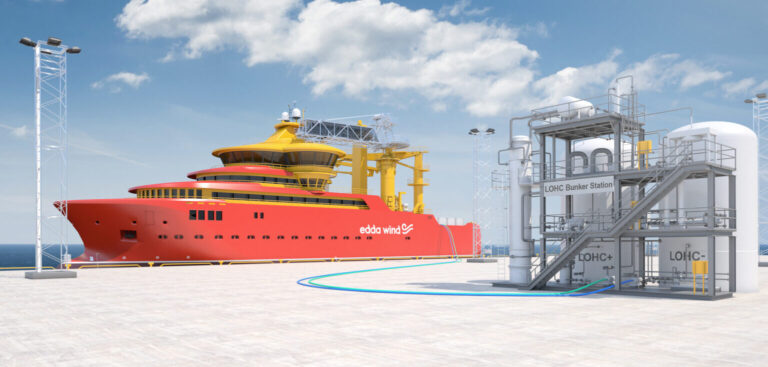A total of €15m (US$16.3m) has been granted by Horizon Europe – the European Union’s key funding program for research and innovation – to the 17-strong Ship-aH2oy consortium to develop and demonstrate a zero-emission propulsion technology on board ships using green hydrogen from liquid organic hydrogen carrier (LOHC) on a megawatt scale. The project is expected to last five years.
The concept will combine liquid organic hydrogen carrier (LOHC) and solid oxide fuel cells (SOFC) for propulsion to deliver a significant emissions improvement over conventional internal combustion engines. Once developed, the LOHC/SOFC powertrain will be demonstrated on board a Commissioning Service Operation Vessel owned by Edda Wind.
Hydrogenious LOHC technology with the thermal oil benzyl toluene as the carrier material – which has already been proven in stationary systems – enables the handling of hydrogen in a safe and efficient way at ambient conditions and by utilizing existing infrastructure. The gaseous hydrogen molecules are bound to and released from the carrier in a chemical catalytic process (hydrogenation/dehydrogenation), without self-discharge over time.
Due to the non-explosive and hardly flammable nature of the carrier, the hazard potential is much lower than diesel, and superior when compared to the volatile nature of ammonia.
During the Ship-aH2oy project, Hydrogenious LOHC Technologies will oversee the design of the LOHC release unit and the integration with the SOFC, while Hydrogenious LOHC Maritime will interface with the external SOFC supplier. The company will also be responsible for installing the entire system on the already prepared Edda Wind vessel.
As project manager for the new-build, Østensjø Rederi will be responsible for the key interface and machinery space contributions. Working collaboratively with ship owner Edda Wind, the pair aim to demonstrate the efficient operation of the onboard power plant using green hydrogen.
Once successfully demonstrated, the LOHC/SOFC systems will be retrofitted to other vessels by Ship-aH2oy partners. As the project progresses, a replication study for the developed LOHC/SOFC system will be conducted to enable easy replication of the solution for service and ro-pax-vessels.
“The very special technological twist in the Ship-aH2oy project will be the targeted high-level thermal integration allowing SOFC residual heat to be used in the hydrogen release unit for the endothermic dehydrogenation process,” explained Dr Caspar Paetz, CTO of Hydrogenious LOHC Technologies. “With this targeted efficient heat integration, a high overall system efficiency can be achieved. Along with the inherent safety and handling benefits of LOHC, this makes it the very viable emission-free fuel for ships.”
“Within the Ship-aH2oy project, we will enter the range of megawatt drive power provided by emission-free LOHC technology,” commented Øystein Skår, general manager at Hydrogenious LOHC Maritime. “This depicts a relevant power range for a wide operation range of service operation vessels and other ship types. Thus, in Ship-aH2oy, a significant reduction of greenhouse gas emissions can be achieved for a specific ship. Moreover, the project is a large step toward the serial production of onboard LOHC power systems in the megawatt range.”
“This grant demonstrates that the EU believes that LOHC is a technology that can cut emissions from offshore shipping,” said Egil Arne Skare, chief project officer at Østensjø Rederi. “The EU support allows us to test this ground-breaking technology on board, and at the same time show that maritime operations for offshore wind can be carried out emission-free. Østensjø Rederi is proud to take part in a project that will make it easier to get more zero-emission ships with LOHC solutions at sea in the future.”



